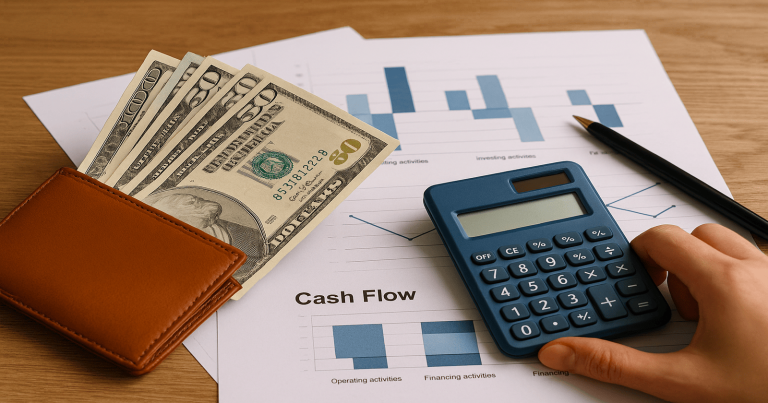In every business and personal finance situation, money flows in and out. When money comes in, we call it cash inflow. When money goes out, we call it cash out. In simple words, cash out is the money you spend. This can be for buying goods, paying bills, giving salaries, paying rent, or buying equipment. Cash out shows how much money you are using to keep the business running. If your outflows are more than your inflows, your business may run into problems. You may not have enough cash to pay suppliers or invest in growth. That’s why it is important to track and manage it carefully.You can understand your business health by checking your cash out. If it is too high without good returns, you need to change something. If you reduce wasteful spending, you can improve your profits. It helps in budgeting, planning, and making better decisions.
What Does Cash Out Mean?
Cash out is the money that leaves a company or person’s account. It happens when you pay for goods, services, or other expenses. It can be small daily costs or big one-time expenses. It also includes payments for business loans, taxes, and investments.
In simple terms, if you pay for rent, electricity, or raw materials, that’s cash out. You need to run the business, but you must balance it with cash inflow to stay healthy.
Why is it Important?
If you don’t track cash outs, you may overspend. You may also face cash shortages when you need to buy stock or pay staff. Knowing your outs helps you:
- Plan better
- Reduce waste
- Avoid cash shortage
- Increase profit
- Make informed decisions
It also helps you prepare a cash flow statement that shows your inflow and outflow together.
Types of Cash out
There are many types of cash out. Some are regular, like salaries. Some are one-time, like buying equipment. Let’s look at the common ones.
1. Operating Cash out
Operating cash out refers to the money spent in the course of the company’s regular, day-to-day operations. These include payments made to suppliers for raw materials or inventory, wages and salaries paid to employees, utility bills, office rent, and other administrative expenses.This includes everyday spending needed to run the business. These are regular expenses like
- Salaries and wages
- Rent and utilities
- Buying raw materials
- Office supplies
- Repairs and maintenance
Businesses must keep these outflows under control. If they grow too fast, profits can shrink.
2. Investing Cash out
Investing cash outflows are tied to long-term investments and asset purchases that will help grow or maintain the business. When a company buys land, buildings, machinery, or equipment, or when it acquires another business, it spends cash as part of its investing activities. This happens when a company buys long-term assets like:
- Equipment or machines
- Land or buildings
- Vehicles
- Software and technology
These costs don’t happen every month. But they are large and affect cash flow in a big way.
3. Financing Cash out
Financing cash outflows represent cash used to fund the business’s capital structure. These outflows happen when the company pays back its debts (such as loans or bonds), pays dividends to its shareholders, or buys back its own shares. This includes money paid to investors, banks, or lenders. It covers:
- Loan repayments
- Interest payments
- Dividend payments
This kind of out must be planned well, or it may hurt cash availability.
| Type | Examples | Frequency |
| Operating out | Rent, salary, raw materials | Monthly |
| Investing out | Buying machines or buildings | Yearly/Occasional |
| Financing out | Loan or interest payment | Monthly/Quarterly |
Managing each type helps improve cash flow management for small businesses and big companies too.
How to Calculate Cash out?
You can calculate cash out using a simple method. Just add all the money you paid during a period.Cash out means total amount of cash that went outside the business due its activities. Therefore, all the payments made by the business in a period is added to derive total cash out
Formula:
| Cash out = Sum of all outgoing payments in a period |
Choose a time period—weekly, monthly, or yearly. Add all expenses for that time. Include:
- Rent
- Utilities
- Salaries
- Purchases
- Repairs
- Loan payments
Example:
Let’s say a business spends the following in one month:
- Rent: ₹20,000
- Salaries: ₹50,000
- Raw materials: ₹30,000
- Electricity: ₹5,000
- Loan Repayment: ₹10,000
Total Cash out = ₹20,000 + ₹50,000 + ₹30,000 + ₹5,000 + ₹10,000 = ₹1,15,000
This means the business spent ₹1,15,000 that month.
Examples of Cash out in Real Life
Following examples depict real life scenarios where businesses spend money, which leads to outflow of cash from the business:
Example 1: Retail Store
A retail shop sells clothes. Every month it spends:
- ₹10,000 on rent
- ₹15,000 on staff salary
- ₹20,000 on buying clothes
- ₹3,000 on electricity
Its monthly cash out is ₹48,000. The shop owner tracks it to avoid spending more than earnings.
Example 2: Small Café
A café owner pays:
- ₹25,000 on rent and bills
- ₹30,000 on raw food items
- ₹20,000 in staff wages
- ₹5,000 in maintenance
Cash out = ₹80,000
If sales are ₹1,00,000, then profit is ₹20,000 before other costs. This helps the owner see if the business is doing well.
These examples show how knowing your cash out helps you take better control of money.
Cash out vs Cash Inflow
Cash outflow is when business spends money under operating, investing and financing activities, whereas cash inflow is when business receives money due to its operating , investing and financing activities.
| Factor | Cash Inflow | Cash out |
| Direction | Money coming in | Money going out |
| Impact | Increases cash | Decreases cash |
| Examples | Sales, loans, funding | Rent, wages, purchases |
You must keep inflow higher than out to build savings and profit. If cash outflow is more, you must take steps to cut costs or boost sales.
How to Manage Cash out Effectively?
You can control your cash flow by planning your outs. Here’s the list of steps , any business can undertake to control cash out :
1. Make a Budget: Always set a monthly or yearly budget. Write down all expected costs. Stick to this plan.
2. Cut Unwanted Costs: Check your spending and remove what’s not needed. Save on power, rent, or extra supplies.
3. Negotiate Better Deals: Talk to your suppliers for discounts. Try buying in bulk.
4. Delay Big Purchases: If cash is low, delay new equipment or upgrades. Focus on essentials.
5. Use Tools: Use simple accounting apps or spreadsheets. They help track where your money goes.
Relevance to ACCA Syllabus
In ACCA, understanding cash outflows is essential in both Financial Management and Financial Reporting. Cash flow knowledge helps in the preparation and analysis of cash flow statements, budgetary controls, and assessing investment appraisals—all core competencies for strategic decision-making.
Cash Out ACCA Questions
Q1: Which of the following is typically a cash outflow from operating activities?
A) Depreciation expense
B) Increase in accounts payable
C) Payment of salaries
D) Issuance of shares
Answer: C) Payment of salaries
Q2: In a discounted cash flow model, which of the following is considered a cash outflow?
A) Residual value of an asset
B) Initial investment in a project
C) Dividend income
D) Depreciation
Answer: B) Initial investment in a project
Q3: Under IAS 7, which is classified as a financing cash outflow?
A) Interest received
B) Purchase of inventory
C) Repayment of loan principal
D) Payment of taxes
Answer: C) Repayment of loan principal
Q4: Which of these transactions causes a cash outflow under investing activities?
A) Sale of plant
B) Acquisition of a subsidiary
C) Loan received from a bank
D) Share issue proceeds
Answer: B) Acquisition of a subsidiary
Relevance to US CMA Syllabus
In the US CMA syllabus, cash flow analysis is part of External Financial Reporting and Performance Management. Knowing the nature and classification of cash outflows helps professionals evaluate liquidity, financial strength, and strategic budgeting.
Cash Out CMA Questions
Q1: Which item is considered a cash outflow in the cash flow from financing activities section?
A) Purchase of marketable securities
B) Payment of dividends
C) Collection from customers
D) Depreciation
Answer: B) Payment of dividends
Q2: What is a capital budgeting-related cash outflow?
A) Depreciation on fixed assets
B) Cost of training staff
C) Initial cost of machinery
D) Revenue from operations
Answer: C) Initial cost of machinery
Q3: Which one of the following is an indirect cash outflow in a budgetary planning model?
A) Tax amortization
B) Sunk cost
C) Variable manufacturing cost
D) Opportunity cost
Answer: C) Variable manufacturing cost
Relevance to CFA Syllabus
In the CFA Program (especially Level I and II), cash outflows play a key role in financial statement analysis, corporate finance, and portfolio management. Analysts must understand and project cash flows to evaluate firm performance and valuation.
Cash Out CFA Questions
Q1: Which of the following is a typical cash outflow in free cash flow to the firm (FCFF)?
A) Tax shield
B) Capital expenditures
C) Interest income
D) Net borrowings
Answer: B) Capital expenditures
Q2: Which of the following is NOT a cash outflow in working capital calculations?
A) Increase in accounts receivable
B) Increase in accounts payable
C) Inventory purchases
D) Prepaid expenses
Answer: B) Increase in accounts payable
Q3: When analyzing an acquisition, which is usually the largest cash outflow?
A) Consultant fees
B) Goodwill amortization
C) Purchase price paid
D) Transaction tax
Answer: C) Purchase price paid
Relevance to US CPA Syllabus
The US CPA exam emphasizes cash flow classifications across FAR (Financial Accounting and Reporting) and BEC (Business Environment & Concepts) sections. Candidates must accurately classify cash outflows for compliance with US GAAP and effective corporate planning.
Cash Out CPA Questions
Q1: Which of the following is an investing cash outflow under US GAAP?
A) Collection from loan receivable
B) Purchase of equipment
C) Interest paid
D) Rent paid
Answer: B) Purchase of equipment
Q2: What type of activity does cash paid to settle a lawsuit fall under?
A) Operating activity
B) Financing activity
C) Investing activity
D) Non-cash activity
Answer: A) Operating activity
Q3: Which of these causes a cash outflow in the statement of cash flows?
A) Amortization of a bond premium
B) Payment for bond issuance costs
C) Stock dividend
D) Deferred tax adjustment
Answer: B) Payment for bond issuance costs


